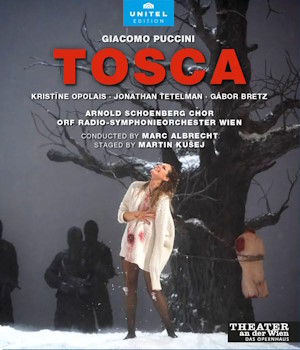
Giacomo Puccini (1858-1924)
Tosca, opera in three acts (1900)
Tosca: Kristine Opolais
Cavaradossi: Jonathan Tetelman
Scarpia: Gábor Bretz
Sacristan / Sciarrone: Rafał Pawnuk
Cesare Angelotti: Ivan Zinoviev
Spoleta / Police Agent: Andrew Morstein
Countess Attavanti: Sophie Aujesky
Arnold Schoenberg Chor
ORF Radio-Symphonieorchester Wien/Marc Albrecht
Martin Kušej (stage direction)
rec. (live), January 2022, Theater an der Wien, Vienna, Austria
Booklet with notes in German, English and French.
Reviewed in surround sound
Unitel Editions 809704 Blu-ray [123]
The published libretto of Tosca sets the action in real locations in Rome: Act One in the church of Sant’Andrea della Valle; Act Two in the Farnese Palace; Act Three in the Castel Sant’Angelo. It is a historical drama, or at least has a historical background. Sardou’s original five-act play has twenty-three characters, while there are nine in Puccini’s three acts. Much of what is omitted concerns the Napoleonic context of nascent Italian nationalism. Some references remain, not least Cavaradossi’s cries of “Vittoria” in Act Two, on learning of the outcome of the Battle of Marengo, the reason for the precise timing of June 1800.
This setting is clearly not mandatory, even though there are moments when the sung text refers to it. Tosca’s tale of sexual exploitation, police corruption and brutality is a good candidate for scene shifting and time travel, especially to the Fascist Italy of the 1930s, or to other places and eras with oppressive regimes.
In the Theater an der Wien’s 2022 production, the setting is modern but the location is not specific, except that Acts One and Three take place outdoors in a snowy landscape with a parked caravan. A dead tree’s headless and limbless torso is chained to it, and at its foot there is a cross with a Marian image. The caravan’s interior serves as Scarpia’s trailer-trash office. There is no desk and no writing materials, but the camera closes in on a 9-inch cook’s knife left on a chair, and a crucifix hangs on the door. So, we have what we need to slay Scarpia and to respect his corpse at the end of Act Two. Scarpia has a Bond villain costume, a white suit and fur coat. Indoors, his white trousers and cable-knit jumper might in some territories make him appear to be awaiting his turn to bat.
A congregation of boiler-suited labourers sing Te Deum. Some carry shovels, perhaps to bury the recently slain in what a German critic calls “a clerical fascist state where only murder and terror are left to govern”. Thus the cleric Sacristan and Scarpia’s hoodlum Sciarrone are the same character – who is also the Act Three gaoler – so Rafał Pawnuk earns his corn in this production. The focus is on the essential bleakness at the core of the opera. Angelotti, Cavaradossi and Tosca are all trapped and then killed, or forced to kill themselves.
The setting apart, the main innovation concerns the Marchesa Attavanti, only mentioned in the libretto. She is the sister of the escaped Angelotti, and a frequent visitor to the Church where she leaves him provisions. In this production, she appears on stage in all three acts. In Act One, of course, she unwittingly serves as the model for Cavaradossi’s painting, and thus becomes the focus of Tosca’s jealousy and Scarpia’s exploitation of it. In Act Two, Scarpia whispers in her ear, presumably to say that Tosca betrayed Angelotti’s hiding place. This gives Attavanti the motivation at the end to shoot Tosca, who in this setting has no castle battlement to leap from. While this denies Tosca the resolve to kill herself, bringing such an instrumental character as Attavanti onto the stage is mostly effective.
The singing of the three leads is excellent. Kristine Opolais first migrated from chorister to soloist in 2003. She still sounds very fine even in a role with such vocal and histrionic demands. Her Vissi d’arte in Act Two is very affecting, and she acts well. It is perhaps not a good idea for the director to make the character lie down and part her legs for Scarpia, even before she asks him his price. Even so, Opolais acts as if il prezzo is obvious and has to be over and done with, rather than planning to stab her assailant.
The rise of tenor Jonathan Tetelman continues apace. His Cavaradossi confirms him as an important talent, with a ringing Italianate timbre, taste and good musical judgement. Dark good looks, persuasive acting and a notable stage presence help too. His Act Three E lucevan le stele is superb. He is even asked to preface it with that Act’s opening dawn song, as if the Shepherd boy has overslept.
As Scarpia, Gábor Bretz commands the second act, despite the cricket sweater that Tosca takes from his corpse. He really sings the role, with no snarling or other vocal affectations. His bass-baritone insinuates and dominates.
Marc Albecht conducts with authority and passion. He never swamps the singers, and his tempi feel right throughout the evening. The ORF Radio-Symphonieorchester Wien sound as idiomatic as any leading opera house orchestra. The image and surround sound are up to Unitel’s high Blu-ray norm.
Across town, there still is the Vienna State Opera’s vintage production of Tosca, now on a Blu-ray disc, in a far more traditional production (review). Collectors should also consider the Opus Arte film from 2011 of Jonathan Kent’s production for the Royal Opera House, Covent Garden. That too is set in a realistic early 19th-century Rome. The three leads are Jonas Kauffman, Angela Gheorghiu and Bryn Terfel, with Sir Antonio Pappano at the podium.
Roy Westbrook
Help us financially by purchasing from



Production staff
Annette Murschetz, set designer
Su Sigmund, costume designer
Reinhardt Traub, lighting designer
Regula Rapp, dramatic advisor
Tiziano Mancini, video director
Video details
Picture format: 1080i/16:9
Sound format: PCM Stereo/DTS-HD MA 5.1
Region code: A, B, C
Sung in Italian
Subtitles: Italian, English, German, Spanish, French, Korean, Japanese

















